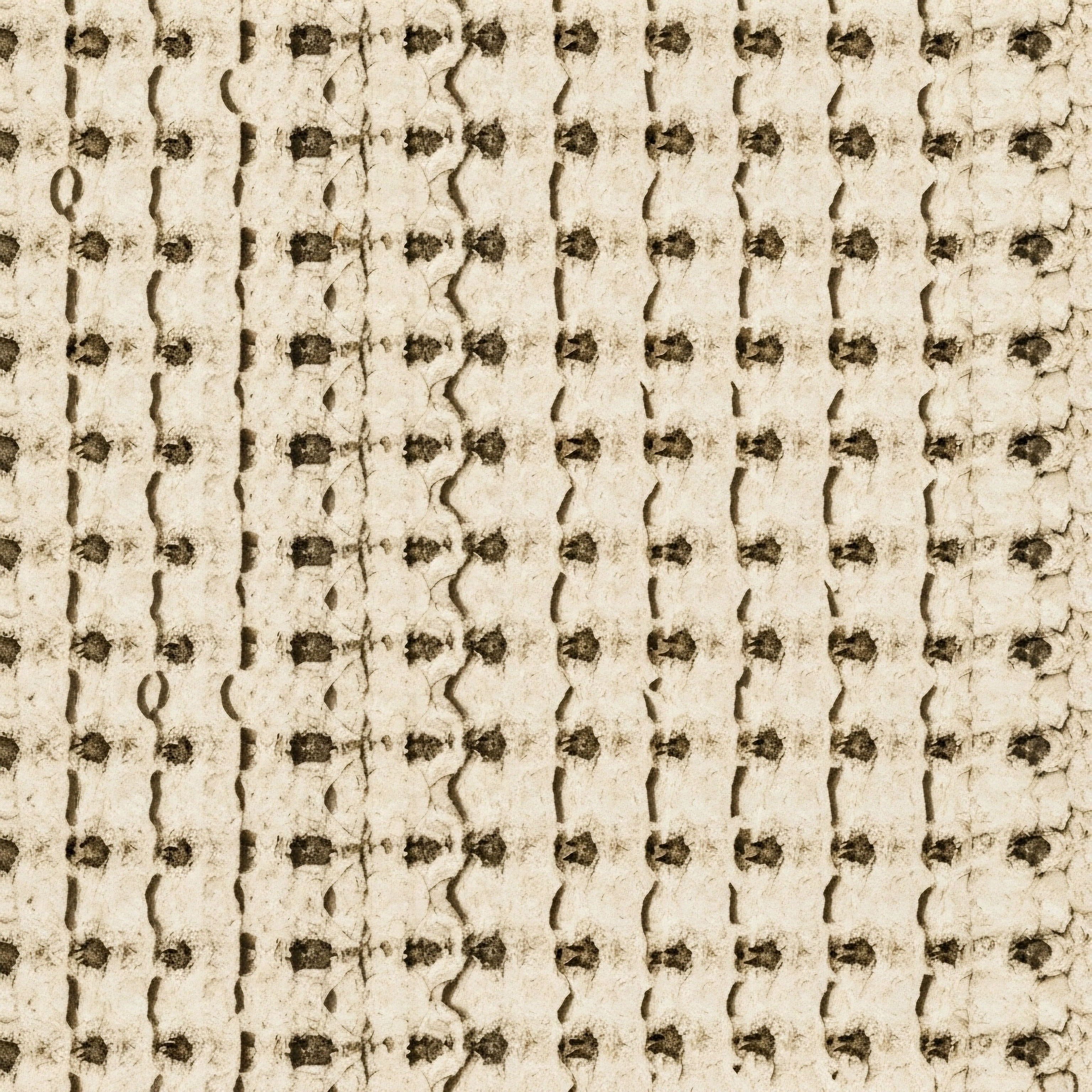

Fundamentals
When your body feels out of sync, when the energy that once propelled you seems to diminish, or when your mental clarity wavers, it is natural to seek explanations. Many individuals experience a subtle yet persistent shift in their overall well-being, often attributing it to the pace of modern life or the natural progression of years.
However, these sensations ∞ a persistent fatigue, a decline in physical vigor, or even a subtle alteration in mood ∞ can frequently point to underlying biochemical imbalances. Understanding these internal systems becomes a personal journey toward reclaiming vitality and function without compromise.
For men, the discussion of hormonal health often centers on testosterone, yet another vital endocrine messenger, estradiol, plays a significant and often overlooked role. Estradiol, while recognized as a primary female sex hormone, is critically important for male physiology.
It is not merely a byproduct of testosterone; it is an active participant in maintaining bone density, supporting cardiovascular health, regulating lipid metabolism, and influencing cognitive function. When estradiol levels fall below an optimal range in men, a cascade of effects can ensue, impacting various bodily systems.
The body’s internal communication network, known as the endocrine system, operates through a complex series of feedback loops. Think of it as a finely tuned thermostat system, constantly adjusting to maintain equilibrium. The hypothalamus, a region within the brain, sends signals to the pituitary gland, which then directs other endocrine glands, such as the testes, to produce hormones.
This intricate dance ensures that hormone levels remain within a healthy range. When this delicate balance is disrupted, symptoms can arise, prompting a deeper investigation into the underlying causes.
Understanding low estradiol in men requires examining its impact on bone density, cardiovascular health, and cognitive function, recognizing its vital role beyond typical associations.

Initial Considerations for Hormonal Assessment
The first step in addressing any perceived shift in well-being involves a comprehensive assessment of your subjective experiences. Are you noticing changes in your sleep patterns, body composition, or emotional state? These personal observations provide invaluable context for any subsequent clinical investigation.
A thorough discussion with a healthcare professional, one who understands the complexities of endocrine system support, forms the bedrock of this diagnostic process. This initial dialogue helps to frame the clinical picture, guiding the selection of appropriate diagnostic steps.
A foundational understanding of your current health status involves reviewing your medical history, lifestyle habits, and any medications you may be taking. Certain medications or chronic health conditions can influence hormonal balance. For instance, some drugs can affect the production or metabolism of sex hormones, potentially contributing to lower estradiol levels. Nutritional status and physical activity levels also exert considerable influence on endocrine function, underscoring the interconnectedness of various physiological systems.

Why Does Estradiol Matter for Men?
Estradiol in men is primarily synthesized from testosterone through an enzyme called aromatase. This conversion process is essential for numerous physiological functions. Optimal estradiol levels contribute to the maintenance of healthy bone mineral density, protecting against conditions like osteoporosis. It also plays a protective role in the cardiovascular system, influencing arterial health and lipid profiles.
Beyond physical attributes, estradiol has a significant impact on brain function, affecting mood regulation, cognitive sharpness, and even libido. A deficiency can therefore manifest in a variety of ways, extending beyond what might be conventionally associated with male hormonal health.


Intermediate
Once subjective experiences and medical history have been thoroughly reviewed, the next logical progression involves precise biochemical measurements. The diagnostic steps for identifying low estradiol in men extend beyond a single blood test; they involve a strategic sequence of analyses designed to paint a comprehensive picture of endocrine function. This methodical approach allows for the identification of specific imbalances and helps to differentiate between various potential causes.
A key aspect of this diagnostic journey involves a detailed blood panel. The timing of blood collection is often important, typically performed in the morning when hormone levels are generally at their peak. This consistency helps ensure accurate and comparable results. The panel should include not only estradiol but also other hormones that influence its production and metabolism.
Accurate diagnosis of low estradiol in men requires a comprehensive morning blood panel, including testosterone, LH, FSH, and SHBG, to assess the full endocrine landscape.

Essential Diagnostic Blood Markers
To accurately assess estradiol status and its underlying causes, several specific blood markers are typically measured. These markers provide insights into the function of the Hypothalamic-Pituitary-Gonadal (HPG) axis, the central regulatory system for sex hormone production.
- Total Testosterone ∞ This provides an overall measure of the primary male sex hormone, from which estradiol is derived. Low total testosterone often correlates with low estradiol.
- Free Testosterone ∞ This represents the biologically active portion of testosterone, unbound to proteins, which is readily available for conversion to estradiol.
- Estradiol (E2) ∞ A direct measurement of estradiol levels. It is important to use a highly sensitive assay, such as liquid chromatography-tandem mass spectrometry (LC-MS/MS), for accurate measurement in men, as standard immunoassays can be less precise at lower concentrations.
- Luteinizing Hormone (LH) and Follicle-Stimulating Hormone (FSH) ∞ These pituitary hormones regulate testicular function. Elevated LH and FSH with low testosterone and estradiol suggest a primary testicular issue, while low LH and FSH suggest a pituitary or hypothalamic problem.
- Sex Hormone Binding Globulin (SHBG) ∞ This protein binds to sex hormones, influencing their bioavailability. High SHBG can reduce free testosterone and, consequently, estradiol.
- Prolactin ∞ Elevated prolactin can suppress GnRH, LH, and FSH, leading to secondary hypogonadism and low estradiol.
- Thyroid Hormones (TSH, Free T3, Free T4) ∞ Thyroid dysfunction can impact overall metabolic and hormonal balance, indirectly affecting sex hormone levels.
- Metabolic Markers ∞ Fasting glucose, insulin, and lipid panel can provide context, as metabolic health is closely intertwined with endocrine function.

Interpreting the Hormonal Landscape
The interpretation of these results is not a simple matter of checking individual numbers against a reference range. It involves understanding the relationships between these markers. For instance, if estradiol is low, the next step is to examine testosterone levels.
If testosterone is also low, the LH and FSH levels help differentiate between a primary testicular issue (high LH/FSH) and a central regulatory problem (low LH/FSH). This distinction is vital for guiding appropriate intervention strategies, such as Testosterone Replacement Therapy (TRT) or the use of agents like Gonadorelin to stimulate endogenous production.
Consider a scenario where a man presents with symptoms of low energy and reduced libido, and initial blood work reveals low estradiol alongside low total and free testosterone, but with normal or low LH and FSH. This pattern points towards a central issue, possibly originating from the hypothalamus or pituitary gland.
In such cases, the therapeutic approach might involve stimulating the body’s own hormone production through agents like Gonadorelin, which mimics the action of GnRH, or Enclomiphene, which can increase LH and FSH secretion.
Conversely, if low estradiol is accompanied by low testosterone and elevated LH and FSH, it suggests a primary testicular insufficiency. Here, the testes are not responding adequately to the pituitary’s signals. In these instances, direct hormonal optimization protocols, such as weekly intramuscular injections of Testosterone Cypionate, become a primary consideration. The goal is to restore physiological levels of testosterone, which will then allow for adequate conversion to estradiol, supporting overall well-being.
A table summarizing key diagnostic markers and their implications for low estradiol in men follows ∞
| Diagnostic Marker | Typical Range (Men) | Implication for Low Estradiol |
|---|---|---|
| Estradiol (E2) | 10-40 pg/mL (LC-MS/MS) | Direct indicator of low estradiol; values below this range warrant investigation. |
| Total Testosterone | 300-1000 ng/dL | Low levels often correlate with low estradiol due to reduced substrate for aromatization. |
| Free Testosterone | 50-200 pg/mL | Low levels indicate less biologically available testosterone for conversion. |
| Luteinizing Hormone (LH) | 1.8-8.6 IU/L | Elevated with low testosterone/estradiol suggests primary hypogonadism; low suggests secondary. |
| Follicle-Stimulating Hormone (FSH) | 1.5-12.4 IU/L | Similar to LH, helps differentiate primary vs. secondary testicular dysfunction. |
| Sex Hormone Binding Globulin (SHBG) | 10-50 nmol/L | High levels can reduce free testosterone, indirectly affecting estradiol. |


Academic
The intricate dance of the endocrine system, particularly the HPG axis, provides a profound understanding of how estradiol levels are regulated in men. This axis represents a sophisticated communication network, beginning in the brain and extending to the testes, orchestrating the production and release of sex hormones. When we consider low estradiol, we are not merely observing a single number; we are examining a potential disruption within this complex biological symphony.
The hypothalamus releases Gonadotropin-Releasing Hormone (GnRH) in a pulsatile fashion. This pulsatility is critical for stimulating the pituitary gland. The pituitary, in turn, secretes LH and FSH. LH acts on the Leydig cells in the testes to stimulate testosterone production, while FSH supports spermatogenesis in the Sertoli cells.
Testosterone, once produced, can then be converted to estradiol by the aromatase enzyme, primarily in adipose tissue, liver, and brain. Estradiol, along with testosterone, then exerts negative feedback on both the hypothalamus and the pituitary, regulating their output of GnRH, LH, and FSH. This feedback mechanism ensures hormonal equilibrium.
Low estradiol in men can signal a disruption in the HPG axis, impacting bone density, cardiovascular health, and neurocognitive function.

Pathophysiological Underpinnings of Low Estradiol
A deeper exploration into the causes of low estradiol in men reveals several potential pathophysiological pathways. One primary cause is insufficient testosterone production, as estradiol is a metabolite of testosterone. This can stem from primary hypogonadism, where the testes themselves are unable to produce adequate testosterone despite robust pituitary signaling.
Conditions such as Klinefelter syndrome, testicular trauma, or certain infections can lead to this. Alternatively, secondary hypogonadism arises from a dysfunction in the hypothalamus or pituitary, leading to inadequate LH and FSH secretion, which subsequently reduces testicular testosterone output. Pituitary tumors, chronic stress, or certain medications can contribute to this central regulatory failure.
Beyond testosterone deficiency, specific enzymatic issues can contribute to low estradiol. A rare condition known as aromatase deficiency, an autosomal recessive disorder, results in the inability to convert androgens (like testosterone) into estrogens. Individuals with this condition present with extremely low or undetectable estradiol levels despite normal or elevated testosterone.
This highlights the direct role of aromatase in estradiol synthesis in men. Understanding such specific genetic or enzymatic defects requires specialized diagnostic testing, including genetic analysis, in addition to standard hormonal panels.

Systemic Implications of Estradiol Deficiency
The ramifications of chronically low estradiol in men extend across multiple physiological systems, underscoring its broad biological significance.
- Bone Mineral Density ∞ Estradiol is a key regulator of bone health in men. It promotes bone formation and inhibits bone resorption. Low estradiol levels are strongly associated with reduced bone mineral density and an increased risk of osteoporosis and fractures. This is a significant concern, particularly in older men.
- Cardiovascular Health ∞ While testosterone’s role in cardiovascular health is often debated, estradiol appears to exert protective effects on the endothelium, influencing vascular tone and lipid profiles. Chronically low estradiol may contribute to increased cardiovascular risk factors, including dyslipidemia and arterial stiffness.
- Neurocognitive Function and Mood ∞ Estradiol receptors are widely distributed throughout the brain, influencing mood, cognition, and neuroprotection. Men with low estradiol may experience symptoms such as reduced cognitive sharpness, altered mood states, and diminished libido. This connection highlights the hormone’s role in central nervous system function.
- Metabolic Function ∞ Estradiol plays a part in metabolic regulation, influencing insulin sensitivity and fat distribution. Imbalances can contribute to metabolic dysregulation, potentially impacting body composition and energy metabolism.
The therapeutic approach to low estradiol in men often involves addressing the underlying testosterone deficiency. Testosterone Replacement Therapy (TRT), typically administered as weekly intramuscular injections of Testosterone Cypionate, aims to restore physiological testosterone levels. This, in turn, provides ample substrate for aromatase to convert into estradiol, thereby normalizing estradiol levels.
In some cases, if estradiol levels become excessively high during TRT, an aromatase inhibitor like Anastrozole may be introduced at a low dose (e.g. 2x/week oral tablet) to modulate the conversion and maintain an optimal estradiol-to-testosterone ratio. The goal is not to eliminate estradiol but to maintain it within a healthy physiological range for men.
For men seeking to maintain fertility while optimizing hormonal balance, or those discontinuing TRT, specific protocols are employed. These often involve agents that stimulate endogenous hormone production. Gonadorelin, administered via subcutaneous injections, can stimulate pulsatile GnRH release, thereby promoting LH and FSH secretion and subsequent testosterone production.
Medications like Tamoxifen and Clomid (clomiphene citrate) are selective estrogen receptor modulators (SERMs) that block estrogen’s negative feedback at the hypothalamus and pituitary, leading to increased LH and FSH, and consequently, increased testosterone and estradiol. These strategies represent a sophisticated approach to biochemical recalibration, aiming to restore the body’s innate hormonal intelligence.

How Does Estradiol Influence Male Bone Health?
The impact of estradiol on male bone health is a compelling area of study, revealing its indispensable role. Estradiol acts directly on bone cells, including osteoblasts (bone-forming cells) and osteoclasts (bone-resorbing cells). It promotes the survival and activity of osteoblasts while inhibiting the activity of osteoclasts.
This dual action leads to a net increase in bone mineral density. In men, even though testosterone is present, it is often the conversion to estradiol that mediates many of testosterone’s beneficial effects on bone. A deficiency in estradiol, regardless of testosterone levels, can therefore predispose men to bone loss and increased fracture risk. This highlights why measuring estradiol is a critical component of assessing bone health in men, particularly those with symptoms of hypogonadism or unexplained bone fragility.
A deeper look at the interconnectedness of hormonal systems and their impact on overall well-being ∞
| Hormone/Peptide | Primary Action | Relevance to Estradiol in Men |
|---|---|---|
| Testosterone | Primary male androgen, substrate for estradiol synthesis. | Low levels directly lead to low estradiol; TRT restores substrate. |
| Gonadorelin | Stimulates pulsatile GnRH release from hypothalamus. | Increases LH/FSH, boosting endogenous testosterone and subsequent estradiol. |
| Anastrozole | Aromatase inhibitor. | Reduces conversion of testosterone to estradiol; used to manage excessive E2 during TRT. |
| LH/FSH | Pituitary hormones regulating testicular function. | Diagnostic markers for primary vs. secondary hypogonadism affecting estradiol. |
| Sermorelin/Ipamorelin | Growth Hormone Releasing Peptides. | While not directly affecting estradiol, they influence overall metabolic health, which can indirectly support endocrine balance. |

References
- Veldhuis, Johannes D. et al. “Estradiol and Testosterone Interact to Regulate the Hypothalamic-Pituitary-Gonadal Axis in Healthy Men.” Journal of Clinical Endocrinology & Metabolism, vol. 96, no. 11, 2011, pp. 3456-3464.
- Finkelstein, Joel S. et al. “Gonadal Steroids and Body Composition, Strength, and Sexual Function in Men.” New England Journal of Medicine, vol. 367, no. 19, 2012, pp. 1795-1807.
- Khosla, Sundeep, et al. “Estrogen and Bone Health in Men.” Journal of Bone and Mineral Research, vol. 26, no. 7, 2011, pp. 1403-1407.
- Rochira, Vincenzo, et al. “Aromatase Deficiency in Men ∞ A Clinical and Molecular Update.” Journal of Endocrinological Investigation, vol. 37, no. 1, 2014, pp. 1-10.
- Davis, Susan R. et al. “Testosterone for Women ∞ The Clinical Practice Guideline of The Endocrine Society.” Journal of Clinical Endocrinology & Metabolism, vol. 101, no. 10, 2016, pp. 3644-3668.
- Bhasin, Shalender, et al. “Testosterone Therapy in Men With Hypogonadism ∞ An Endocrine Society Clinical Practice Guideline.” Journal of Clinical Endocrinology & Metabolism, vol. 103, no. 5, 2018, pp. 1715-1744.
- Jones, H. A. et al. “The Role of Estrogen in Male Bone Health.” Current Osteoporosis Reports, vol. 14, no. 4, 2016, pp. 159-166.
- Miller, Kevin K. et al. “Effects of Testosterone and Estradiol on Cognition in Healthy Men.” Journal of Clinical Endocrinology & Metabolism, vol. 94, no. 7, 2009, pp. 2511-2518.

Reflection
The journey to understanding your own biological systems is a deeply personal one, often beginning with a subtle shift in how you experience your daily life. The knowledge shared here, detailing the diagnostic steps for low estradiol in men, is not merely a collection of facts; it is a framework for introspection.
Consider how these intricate hormonal feedback loops and their systemic effects might be influencing your unique physiological landscape. This information serves as a compass, guiding you toward a more informed dialogue with healthcare professionals.
The path to reclaiming vitality is paved with precise understanding and personalized guidance. This exploration into estradiol’s role in male health, and the clinical protocols designed to address imbalances, represents a powerful step. It invites you to consider your body not as a collection of isolated parts, but as an interconnected system, capable of recalibration and renewed function.
Your proactive engagement with this knowledge is the true catalyst for optimizing your well-being and stepping into a future of sustained health.



